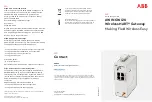
4
784_QSG_Ve
Part No. 200-2352 - v1
Quick Start Guide - 784 DVB-S/S2 LAN-Caster
DVB-S/S2 RF Multiplex Organisation
An ‘RF Multiplex’ is a group of digital TV and radio stations that are ‘grouped’ together in a single RF signal which is then ‘bounced’
off a geo-stationary satellite, down to a user’s satellite dish.
There are a wide variety of satellite services available, and
your choice depends upon your geographical location and which
satellites are ‘bouncing’ signals to your area (the website
www.lyngsat.com has a comprehensive list). A single satellite
can ‘bounce’ over 100 RF multiplexes, each of which can
contain 20 or more TV or radio stations, so there are hundreds of
services available to satellite users. A scan of the Astra satellite
showed 86 RF multiplexes transmitting 1086 TV/Radio channels.
The LAN-Caster is able to scan all the signals coming from
the satellite dish, and automatically detect the DVB-S/S2 RF
multiplexes that it can ‘see’. When it detects a multiplex, it
determines the TV and radio stations that are available and
shows them on the channel setup menu.
Some TV/radio services are encrypted to prevent un-authorised
viewing/listening. These are shown in the Channel Setup menu
with a ‘padlock’ symbol. This stream can be passed onto the
network, but IPTV decoders or PC software will have to decrypt
the stream before it can be viewed. The LAN-Caster can be
fitted with a plug-in CAM module to de-crypt the streams before
launching them on the network.
A single LAN-Caster unit can select ONE RF multiplex, then
extract up to 15 TV or radio services that the user chooses from
that multiplex and stream them onto the IP network. If a user
wants to see more than 15 TV or radio services from a single
multiplex, another LAN-Caster unit will be required. If a user
wants to simultaneously access TV channels from two different
RF multiplexes, then they require two LAN-Caster modules.

























